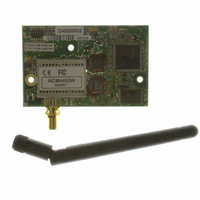20-101-1221 Rabbit Semiconductor, 20-101-1221 Datasheet - Page 79

20-101-1221
Manufacturer Part Number
20-101-1221
Description
RCM4400W (JAPAN TELEC CERTIFIED)
Manufacturer
Rabbit Semiconductor
Series
RabbitCore®r
Datasheet
1.20-101-1202.pdf
(126 pages)
Specifications of 20-101-1221
Frequency
2.4GHz
Modulation Or Protocol
802.11 b
Power - Output
16dBm
Voltage - Supply
3.3V
Current - Receiving
450mA
Current - Transmitting
450mA
Data Interface
Connector, 2 x 25 Header
Memory Size
512K Flash, 1MB SRAM
Antenna Connector
SMA
Operating Temperature
-20°C ~ 85°C
Package / Case
Module
Lead Free Status / RoHS Status
Lead free / RoHS Compliant
Applications
-
Sensitivity
-
Data Rate - Maximum
-
Other names
316-1147
- Current page: 79 of 126
- Download datasheet (2Mb)
Use each command macro in its own
the “rabbit” access point and set a transmit rate of 11 Mbits/s, you would have these two
lines of code in your program.
Let’s look at the individual
WIFI_SSID
An SSID (service set identifier) names a specific wireless LAN (WLAN). All devices on a
single WLAN must share a common SSID. Set this value to your WLAN’s SSID. If you
leave the SSID blank, the Rabbit-based device will associate automatically with the access
point that has the strongest signal. Generally, it is best to set the SSID explicitly so that the
device does not join a WLAN that you were not expecting it to join.
For an infrastructure network (one that uses an access point), this is the name of the network
as configured on the access point.
For an ad-hoc network, this is the name that you want to give the network you created. All
devices on the ad-hoc network must use the same SSID.
WIFI_MULTI_DOMAIN
This command enables or disables your device to be configured by an access point that is
capable of supporting multiple domains according to the 802.11d standard. When your
device is enabled, the access point will provide country information to your device to
identify the regulatory domain in which it is located and to configure its PHY for opera-
tion in that regulatory domain.
User’s Manual
int wifi_ioctl(IF_WIFI0, WIFI_SSID, "rabbit", 0);
int wifi_ioctl(IF_WIFI0, WIFI_TX_RATE, WIFICONF_RATE_11MBPS, 0);
NOTE: The access point must have the 802.11d option enabled with the country selected
according to where your wireless device is deployed.
wifi_ioctl()
wifi_ioctl()
commands and their macro options.
function call. For example, to name
73
Related parts for 20-101-1221
Image
Part Number
Description
Manufacturer
Datasheet
Request
R

Part Number:
Description:
COMPUTER SGL-BRD BL2500 29.4MHZ
Manufacturer:
Rabbit Semiconductor
Datasheet:

Part Number:
Description:
COMPUTER SGL-BRD BL2500 29.4MHZ
Manufacturer:
Rabbit Semiconductor
Datasheet:

Part Number:
Description:
DISPLAY GRAPHIC 12KEY PROG OP670
Manufacturer:
Rabbit Semiconductor
Datasheet:

Part Number:
Description:
DISPLAY GRAPHIC 12KEY ETH OP6700
Manufacturer:
Rabbit Semiconductor
Datasheet:

Part Number:
Description:
COMPUTER SINGLE-BOARD BL2030
Manufacturer:
Rabbit Semiconductor

Part Number:
Description:
COMPUTER SGL-BOARD ETH BL2010
Manufacturer:
Rabbit Semiconductor

Part Number:
Description:
MODULE OP6810 W/O ETH/MEM EXPANS
Manufacturer:
Rabbit Semiconductor
Datasheet:

Part Number:
Description:
COMPUTER SINGLE-BOARD BL2020
Manufacturer:
Rabbit Semiconductor

Part Number:
Description:
COMPUTER BL2010 W/FRICTION LOCK
Manufacturer:
Rabbit Semiconductor

Part Number:
Description:
COMPUTER BL2020 W/FRICTION LOCK
Manufacturer:
Rabbit Semiconductor

Part Number:
Description:
COMPUTER SGL-BRD BL2500 44.2MHZ
Manufacturer:
Rabbit Semiconductor
Datasheet:

Part Number:
Description:
COMPUTER SGL-BOARD FULL BL2000
Manufacturer:
Rabbit Semiconductor

Part Number:
Description:
COMPUTER SINGLE-BOARD BL2110
Manufacturer:
Rabbit Semiconductor

Part Number:
Description:
COMPUTER SGL-BRD 29.4MHZ BL2610
Manufacturer:
Rabbit Semiconductor
Datasheet:

Part Number:
Description:
INTERFACE OP6800 512K FLASH&SRAM
Manufacturer:
Rabbit Semiconductor
Datasheet:










